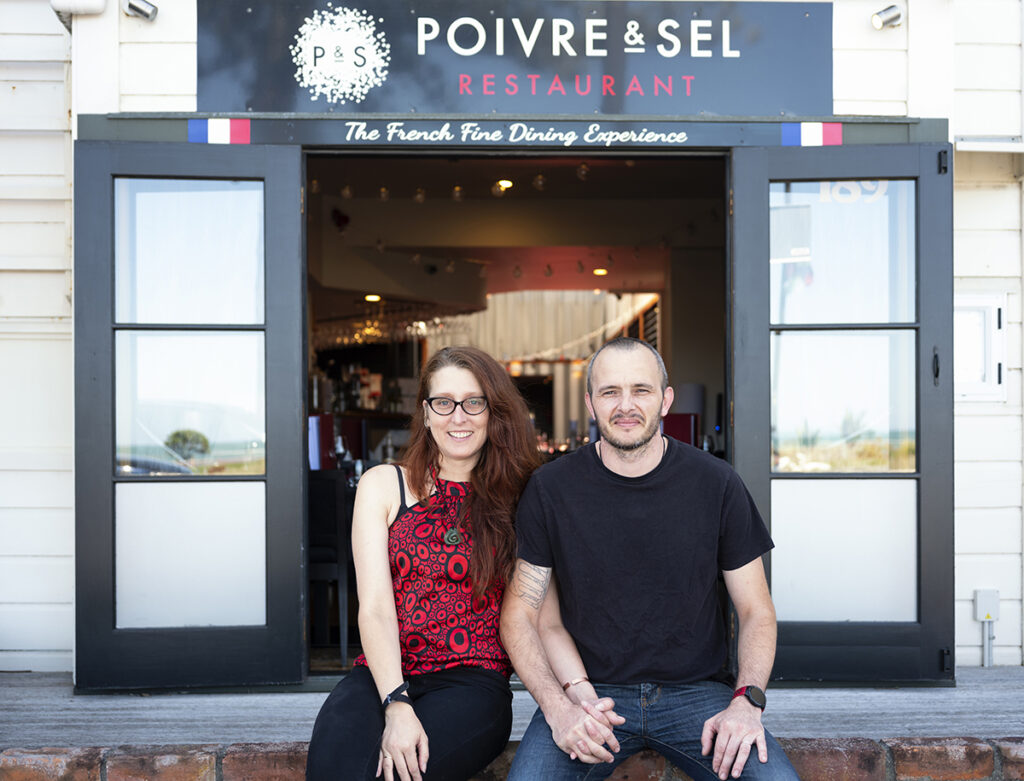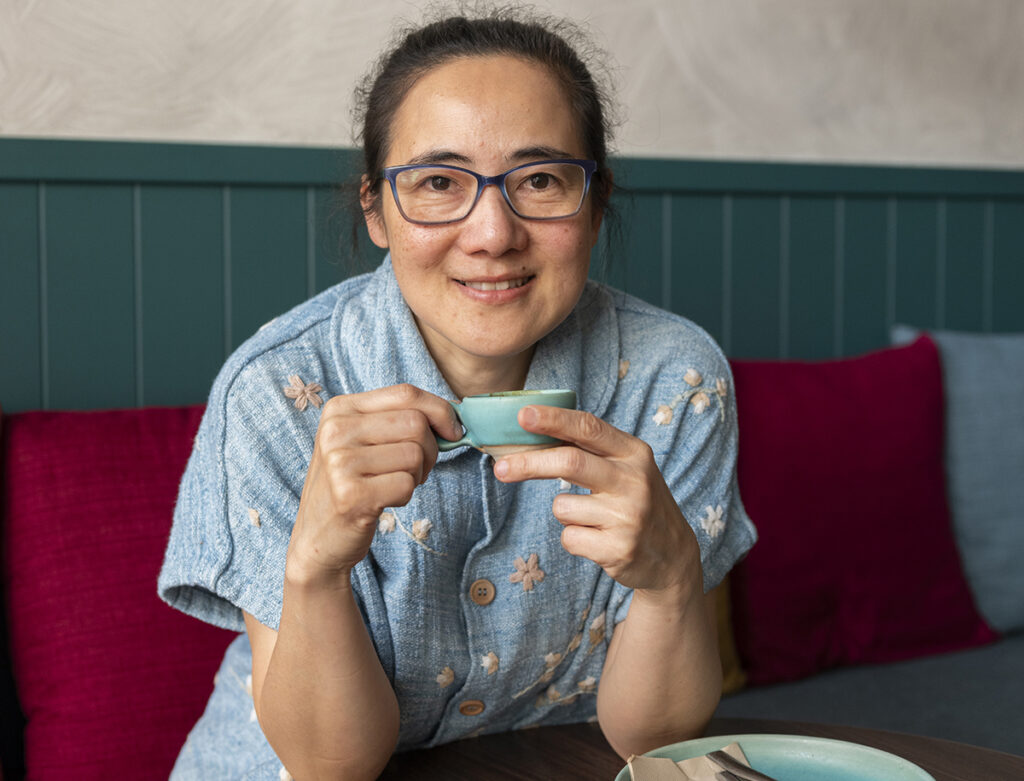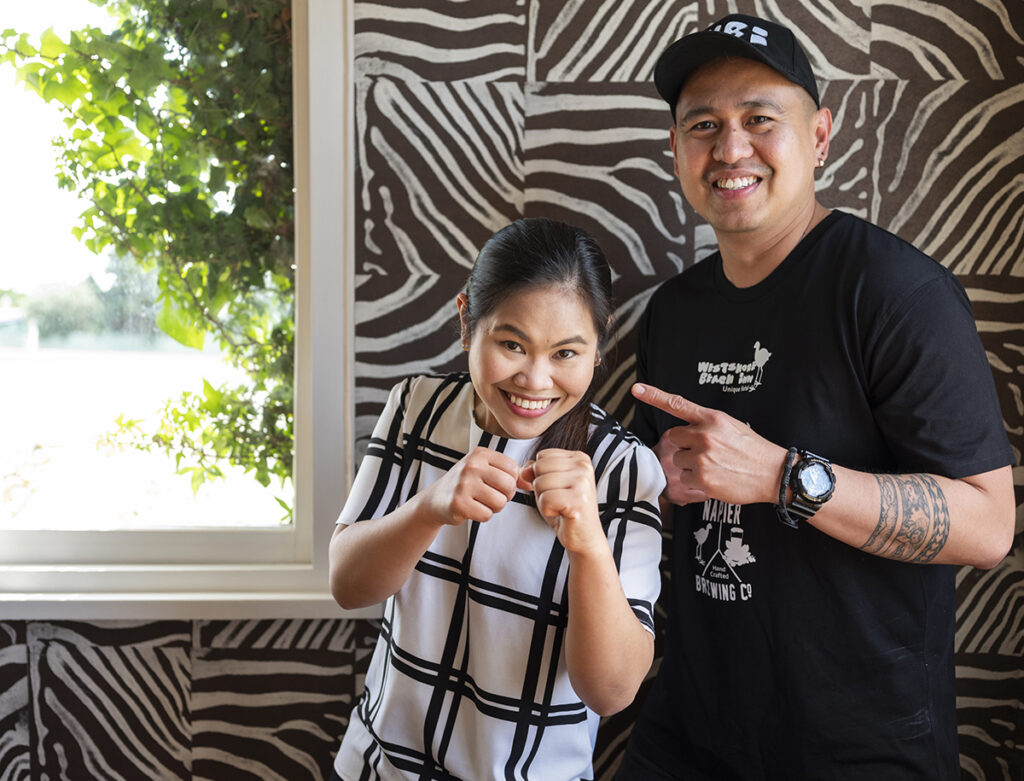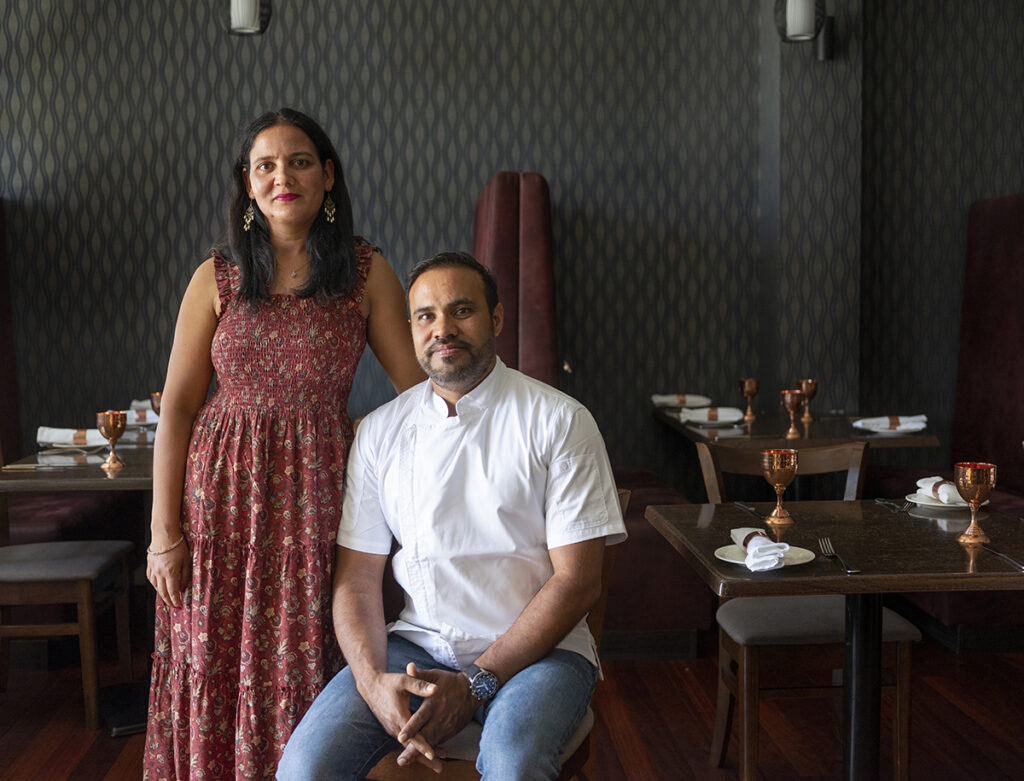Hawke’s Bay has gained a media reputation for restaurant excellence, notably from wineries, and family-operated establishments in Napier.
Cuisine magazine’s 2019 Top New Zealand Restaurants gave Pacifica three hats (one of five in the country) and Bistronomy was awarded two hats, as were Craggy Range and Elephant Hill. David and Pru Barton’s Mr D completed Hawke’s Bay’s top five.
The cuisine of these restaurants can be loosely described as international fusion – combining world-wide culinary traditions, with an emphasis on European. Their standard is up with the best.
Jeremy Rameka, at Pacifica, our most celebrated chef, is French-cuisine trained, and employs that tradition’s emphasis on precision and delicacy when combining various influences – like Lemonfish ceviche (South American) marinated in coconut cream (Thai) with cucumber mousse (French) and wasabi roe (Japanese).
Cuisine said of Pacifica, “The food is modern New Zealand cuisine at its best and Rameka is truly at the forefront of redefining our national food identity.”
Aotearoa New Zealand in 2021 is a mélange of ethnicities, and our top chefs are shaping their menus in recognition of the diversity of cuisines we have in our communities.
Hawke’s Bay is peppered with restaurants and cafes offering ethnic fare, some as true to tradition as they can achieve, others blending with the cuisines of others.
Italy
Alessandro’s
The South African lilt to Alessandro Buttazzoni’s accent is because that’s where he learned to speak English as a teenager, after his father took a job with an engineering company.
His family are from the rural town of San Daniele in the Friuli-Venezia Guila region of North East Italy.
Aged nineteen, Alessandro returned to complete compulsory military service, after which he took up a baker’s apprenticeship in Naples, “learning the traditional wood-fired, brick oven, bread-making craft”. Those skills “gave me the opportunity to travel and work throughout Italy and other European countries.”
Looking to broaden his knowledge and skills, Alessandro undertook a formal culinary degree in Colorado, which led to a partnership in an Italian restaurant in Vail.
Travel and work next took him to Melbourne, where he met his New Zealand partner. They moved to Hawke’s Bay in 2016, and Alessandro went back to his roots, opening a small pizza bar on Havelock Road.
“My passion is the oven, working with raw fire and the dough.”
The pizza oven in Alessandro’s new restaurant on Joll Road is custom made, imported from Naples. “The Acunto family have been making these ovens for four generations. They are the Ferrari of ovens.”
Perfection is the attitude he brings to the making of pizza and breads.
The pizzas are Neapolitan style. The highly-refined OO flour is imported from Naples, because “only the finest flour can take the heat of the oven at 485 degrees Celsius.”
Alessandro says dough making is “very simple”. His ingredients are: OO flour, pure water, sea salt, and his own sour dough yeast starter, fed daily with flour and water.
Perhaps simple, but it is with care and precision. He pre-ferments, mixes and kneads, and allows the dough to rest for three to five days, making Alessandro’s “the best pizza in the country” according to media celebrity, Jesse Mulligan.
Turkey
Kilim
Born in Istanbul, Yusuf Dogru had just finished his higher education in Bosnia-Herzegovina, when in 2007 he and his father visited an old friend, owner of Kilim restaurant in Petone. Yusuf was twenty-one years old.
At first, he waited tables. “I always loved food and cooking but I didn’t think it would be my profession.”
In 2009 Yusuf helped set up Kilim in Napier, and in 2017 he bought the restaurant with business partner, Michael.
With freedom to create their own menu and style, Kilim draws on the ancient roots of Turkish heritage.
“Turkey is a bridge between Asia and Europe,” says Yusuf. “And Istanbul was the economic and political capital of different empires for centuries.” Roman, Byzantine, Ottoman. “From China to England, they all came together in Istanbul, because of the silk and spice roads.”
Yusuf points out that the Ottoman Empire endured over four centuries, and stretched from North Africa to Austria, and from Greece to the Middle East.
He understands Turkish cuisine as “a big mosaic of different cultures”, and his menu reflects that scope.
“We have pljeskavica (Serbian), which are lamb patties prepared Eastern European style.”
Kilim’s tangine – lamb, chicken, beef, clay baked with fruits, nuts, and spices – is North African.
Guvech is a stew with vegetables from western Turkey, as are iskender kebabs. Falafal is an Arabic word, and mezza is Greek.
Perhaps the most striking example of Yusuf’s “cuisine cultural mosaic” is baklava, a sweet dessert, originating in an Ottoman Sultan’s kitchen in Istanbul, yet now found in the cuisines of Egypt, the Middle East, the Balkans, and Central Asia.
Yusuf Dogru has a deep knowledge of the origins of Turkish cuisine and says, “I have always wanted to be a bridge between cultures.”
He has found the perfect vehicle in Kilim.
France
Poivre et Sel
In 2011, Samuel and Severin Goslin sold their possessions, packed their bags, and with two young children, moved to New Zealand.
They were living in Grasse, “perfume capital of the world”, in the Cote-d’Azur region on the French Riviera, running a bar and restaurant. “In France it is very difficult running a small business, with high taxes and operating costs. Much more than here,” says Samuel.
The Goslins found work at Oreti Village Resort in Pukawa, over looking Lake Taupō. Samuel in the kitchen, and Severin was housekeeper and waitress.
After two years they moved to Whitianga and established their own restaurant, Poivre et Sel (Pepper and Salt), but in 2018 a change of landlord and rent increase encouraged them to look elsewhere.
For sale was Little India, located in one of the Six Sisters on Marine Parade, the latest in a string of establishments in the space, that have included Mint and Take Five. “The climate here is similar to the Mediterranean and Hawke’s Bay has great produce from growers like Epicurian, Matangi beef, and many more.”
At Poivre et Sel every dish is made from scratch, including breads, ice cream and sorbet.
The menu offers a classic three-course dinner with optional matching French wines. There are three choices for each course.
“When you make everything, it is very labour intensive,” says Samuel.
“We offer haute cuisine in an informal atmosphere,” says Severin, who, with her two teenage children, Morgane and Mathis, wait tables.
Haute cuisine is characterised as meticulous preparation and careful presentation, and is the high end of French cuisine, contributing to France having the most Michelin-star restaurants of any country in the world.
The Goslins have brought that standard to Hawke’s Bay. “Hearty fare,” says Samuel. “With subtle flavours,” adds Severin.
Thailand
Sai Eatery
The only South East Asian country not colonised, Thailand doesn’t have European culinary influences like Philippines (Spanish) or Vietnam and Laos (French).
Thai cuisine employs unique ingredient combinations, centred around galangal, kaffir lime, lemongrass, lime, chilli, coconut and coriander.
At Sai Eatery, on Emerson Street in Napier, sisters Sasi (manager) and Siriya (chef) offer authentic Thai dishes. “People told me Kiwis don’t like real Thai food, but I didn’t accept that, because it’s not sincere to our traditions.”
Sasi Limapibal was born in Songkhla and has a master’s degree in literature. She was working as a researcher, when another sister living in Sydney announced she wanted to sell her restaurant.
Sasi said, “Sell to me,” and she emigrated to Australia, taking over a big restaurant in Chatswood. Later, she and her partner, yearning for a more peaceful life, left the big city for a small seaside town three hundred kilometres away, where they established a restaurant.
Sai Thai Table and Tea in Old Bar was so successful, Sasi’s dream of a quieter life did not happen. “We were so busy. Local people and tourists loved our food, and would say, so, this is real Thai food.”
When her sister, Siriya, said she wanted to move to New Zealand, Sasi decided to come too, and in 2017 they established Sai Eatery in Napier.
Sasi says the key to their cuisine is “achieving a balance of tastes: hot, sour, sweet, and salty”.
On the menu is Meang kana, made from “an ancient recipe, very complicated and time consuming”, and served in a shot glass. Hot is expressed by chilli, sour by lime juice, sweet by palm sugar, salty by fish sauce.
Other Thai classics, like Tom Yum Goong, Pad Thai, and Larb, are all made “the same way we make them in Thailand”, says Sasi.
Japan
Piku
Hawke’s Bay is flush with sushi and the standard is high. Two family-run, authentic sushi bars, Tu Muke Don in Napier and Everyday Sushi Day in Taradale, are favourites, and people are raving about Aozora in Ahuriri.
Ben Harper, owner of Piku, is an exception to other eateries featured, whose operators are from the ethnicity of their cuisine.
Ben is Hawke’s Bay born and bred. Harper Road in Waimarama is named after one of his tipuna.
He acquired his knowledge and appreciation working in a Japanese restaurant in Chelsea, London, where he rose through the ranks to be general manager.
Returning to New Zealand, Ben went out on his own, establishing Piku, “with a pop-up tent serving events like Horse of the Year, and a few months later I bought a food trailer. Then in November 2017 I set up in Red Barrel Winery.”
Piku was popular from the outset, and eighteen months later, Ben was approached about setting up in Jonathan McHardy’s new hospitality sector development in Joll Road.
“Piku means peak,” says Ben, “and our logo is the Rising Sun and Te Mata.”
The logo matches the style of Piku cuisine, which is strongly Japanese influenced, “with twists”.While in Japan for the Rugby World Cup, Ben traveled out of town to a restaurant specialising in Karaage: marinated meats and fish, coated in flour, deep fried in oil, and usually served with rice and shredded cabbage.
“A twist to fit the taste of our clientele” is Piku Chicken Karaage, which is coated in tempura and served with kimchi mayo.
Ben imported two robatayaki grills from Japan, and credits head chef, Brent Cameron, with perfecting the Yakatori section of the menu: char grilled skewers of meats and fish.
Piku has hit a chord in bringing Japanese inspired cuisine to Hawke’s Bay.
Philippines
PAK
PAK is an anagram for Philippine Asian Kitchen and is sited at the Westshore Beach Inn, tucked into a corner of Jeremy Bayliss’s award-winning establishment of bars, bistro, accommodation, and beer brewing.
The restaurant was established in 2015 by Sanny Palima.
Current chef, Anton Bande, worked with Sanny in Shangri-La Resort in Lapu-Lapu City, Cebu, in 2007. Nine years later, after studying cooking at EIT, Anton applied for a job advertised by PAK. Unbeknown to him, Sanny Palima was the chef.
“We keep to his philosophy of maximising the opportunity to source fresh ingredients from local producers,” says PAK manger, Dawn Veridiano-Mason, whose hometown is Cavite in Luzon. She started in 2016, “after Anton texted me about a managerial vacancy”. They had met at EIT.
“Sadly, we lost Sanny,” says Anton, “he died of heart failure two years ago on holiday in the Philippines.” Anton and Dawn honour Sanny Palima by continuing the style he established, and there’s a photo of him on the menu.
Enduring are two Filipino ‘national dishes’ with Spanish names: Adobo and Lechon, although they were part of indigenous cuisine before Spain’s colonisation (1521-1898).
Adobo translates as ‘marinade’, and Anton explains: “Before refrigeration meats were preserved in vinegar, herbs and spices.” PAK’s version is marinated NZ pork belly and Bostock chicken, “with a difference”. The dish is finished with crispy shallots and quail eggs.
Innovation in blending traditional Filipino fare with other, mostly Asian, influences is PAK’s style.
And with humour, a hat tip to forty years of American colonisation is Dawn’s favourite. “Triple Joy Fried Chicken is named after Chickenjoy from a KFC-style food chain in the Philippines called Jollibee.”
PAK are a close-knit family of mostly Filipino workers, and Dawn credits Jeremy and Carol Bailey “for looking after us and caring about our welfare”.
India
Rasoi
Rasoi, Hindi for kitchen, is aptly named, because owner Kamlesh Prasad says, “The kitchen is the heart of our restaurant.”
In a large charcoal-fired tandoori oven, strips of prior-marinated chicken slowly roast, and on the stove a pot of dahl simmers. Spices are roasted and hand ground.
From Dehradun, capital of Uttarakhand province, near the Himalayan foothills, Kamlesh studied hospitality in Delhi for three years before working in five-star hotels in India’s capital.
In 2005 he took the opportunity to travel to New Zealand to work in a friend’s restaurant in Invercargill. “You can imagine,” says Kamlesh, “I come from metro city Delhi and I felt, where am I, this is so small.”
But he says, “I fell in love with New Zealand,” and since moving to Hawke’s Bay twenty years ago, he is now well settled with a family and appreciates “the wonderful environment, and people are especially nice here.”
Having worked as head chef in other restaurants, in 2017 Kamlesh and his wife Mamta decided to go out on their own. “When you work for someone else, you are limited. Food is my passion. Now, I can create my own menu without restriction.”
Kamlesh describes his menu as ‘pan-Indian’, drawing from the many cuisine traditions of his homeland.
From the far north there’s Kashmiri Rogan Josh: lamb, goat, venison. Bengal is represented by Chicken Rezalla, an aromatic muslim influenced curry. From Mangalore in the south there’s a mango chicken curry; and Anjeer Aur Paneer Kofta, cheese dumplings with fruits and nuts, is a Punjabi dish.
Rasoi sources meats “from Gourmeats in Havelock North, fish is Takatimu, and vegetables are all from local suppliers”.
In his approach to cooking Kamlesh Prasad is mindful of the ‘Ayurvedic traditions’, which advocates use of whole fresh foods for prana and recognises food should be handled with care and treated with respect.
Recovery
All these food impresarios praised the support they have had post Covid-19 lockdown. Some adapted to delivering take-aways, others weren’t able, but as soon as their restaurants reopened, business has been brisk.
“Yes, very busy, with strong bookings ahead.”
“Our regular customers have been wonderfully supportive.”
“We did deliveries during lockdown and ever since we reopened we’ve been hammered every night.”
“We’re as busy since lockdown as we’ve ever been thanks to our loyal customers.”
“Kiwis come together in a crises, and they know if they don’t support the restaurants and cafes, we’ll go out of business.”
“We are really grateful.”
Keep it up, Hawke’s Bay foodies!









Also well worth a mention is Fiko, the Aegean and Middle Eastern eatery in Havelock North. It flies under the radar, but is a really excellent authentic middle eastern food experience.